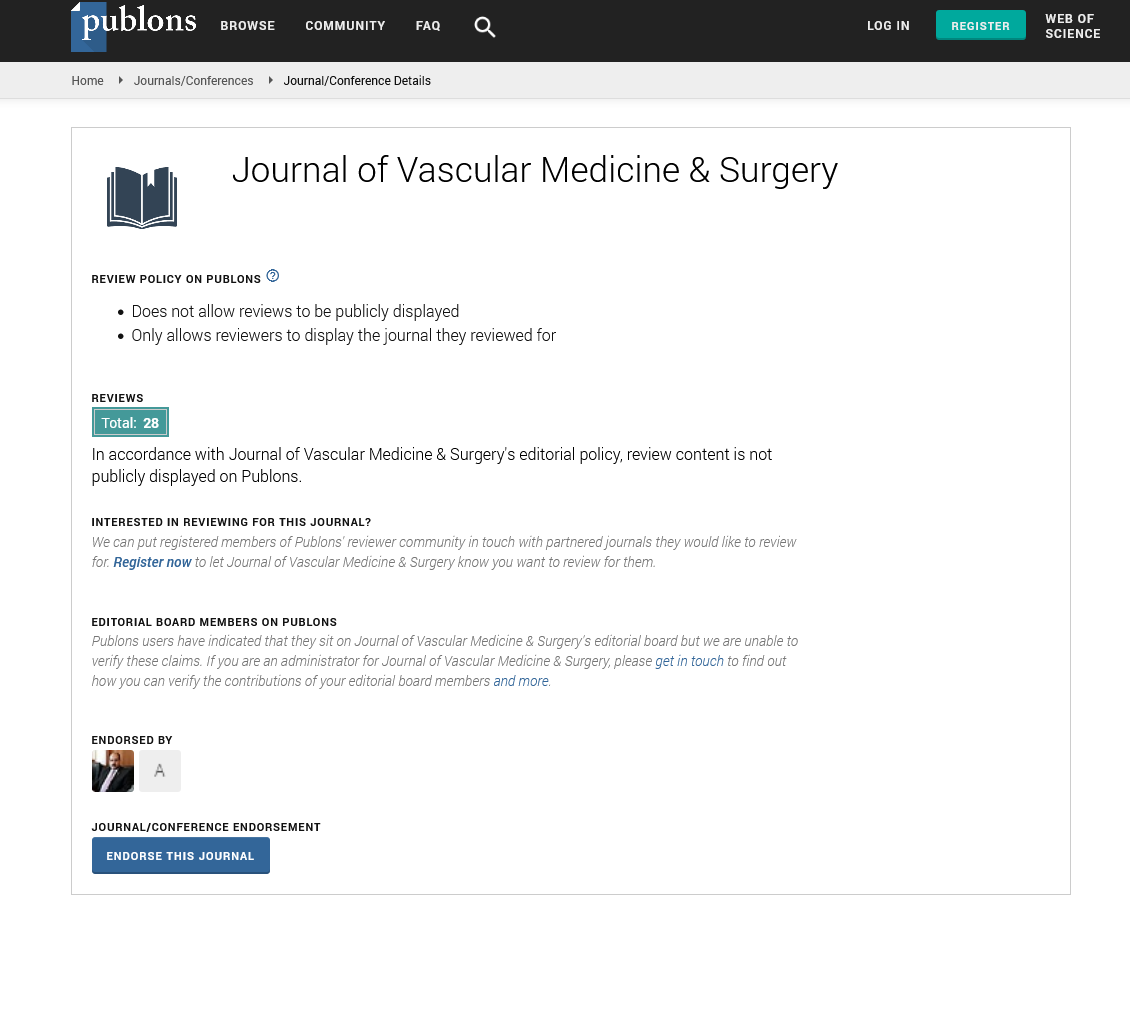Indexed In
- Open J Gate
- Academic Keys
- RefSeek
- Hamdard University
- EBSCO A-Z
- OCLC- WorldCat
- Publons
- Euro Pub
- Google Scholar
- SHERPA ROMEO
Useful Links
Share This Page
Journal Flyer

Open Access Journals
- Agri and Aquaculture
- Biochemistry
- Bioinformatics & Systems Biology
- Business & Management
- Chemistry
- Clinical Sciences
- Engineering
- Food & Nutrition
- General Science
- Genetics & Molecular Biology
- Immunology & Microbiology
- Medical Sciences
- Neuroscience & Psychology
- Nursing & Health Care
- Pharmaceutical Sciences
Commentary Article - (2024) Volume 0, Issue 0
Peripheral Vascular Disease: Its Causes, Symptoms and Risk Factors are Essential for Reducing its Impact on Health and Improving Patient Outcomes
Hosein Nobari*Received: 29-Jul-2024, Manuscript No. JVMS-24-26836; Editor assigned: 31-Jul-2024, Pre QC No. JVMS-24-26836 (PQ); Reviewed: 14-Aug-2024, QC No. JVMS-24-26836; Revised: 21-Aug-2024, Manuscript No. JVMS-24-26836 (R); Published: 30-Aug-2024, DOI: 10.35248/2329-6925.24.S23.554
Description
Peripheral Vascular Disease (PVD), also known as Peripheral Artery Disease (PAD), is a common circulatory condition characterized by the narrowing or blockage of blood vessels outside the heart and brain. The reduction in blood flow primarily affects the arteries that supply blood to the legs and feet but can also impact the arms, stomach and kidneys. PVD is a serious condition that can lead to significant pain, mobility issues and an increased risk of heart attack or stroke. Peripheral vascular disease occurs when the blood vessels that carry oxygen and nutrients to the limbs become narrowed or blocked due to the development of fatty deposits, known as plaque, on the walls of the arteries. This process, known as atherosclerosis, leads to reduced blood flow to the extremities, which can cause pain, especially when walking or exercising. Chronically, PVD can develop, resulting in severe complications such as ulcers, infections and potentially loss of limb.
Causes and risk Factors
Peripheral vascular disease is primarily caused by atherosclerosis, but several factors can contribute to its development and progression. Significant causes and risk factors include: Atherosclerosis is the accumulation of cholesterol, fats and other substances in the arterial walls, forming plaques that narrow and harden the arteries. This is the most common cause of PVD. Smoking is one of the most significant risk factors for PVD, as it damages the blood vessels, increase plaque formation and reduces oxygen in the blood. Smokers are at a significantly higher risk of developing PVD compared to non-smokers. Diabetes increases the risk of PVD due to high blood sugar levels, which can damage blood vessels and nerves. Diabetic patients are also more probable to develop severe forms of PVD. Hypertension increases additional pressure on blood arteries, causing damage and increasing the risk of atherosclerosis. It is a major risk factor for PVD and other cardiovascular diseases. Elevated levels of Low-Density Lipoprotein (LDL) cholesterol contribute to plaque formation in the arteries, increasing the risk of PVD. Excess body weight, especially abdominal fat, it is associated with an increased risk of PVD due to its effects on blood pressure, cholesterol levels and insulin resistance. A sedentary lifestyle can contribute to obesity, high blood pressure and poor cholesterol levels all of which increase the risk of PVD. The risk of developing PVD increases with age, particularly after the age of 50. A family history of PVD, heart disease or stroke can increase an individual’s risk of developing PVD. Kidney disease can contribute to the development of PVD by improving hypertension and atherosclerosis.
Symptoms of peripheral vascular disease
The symptoms of PVD can vary depending on the severity of the condition and the duration of blood flow inhibition. Common symptoms include.
Hair loss on the legs or feet: A decrease in blood flow can lead to hair loss on the legs or feet, as well as a reduction in nail growth.
Erectile dysfunction: In men, PVD can affect blood flow to the pelvic region, this results in a condition called erectile dysfunction.
Weak or absent pulses in the legs: Reduced blood flow can result in weak or absent pulses in the legs or feet, which can be detected during a physical examination.
Numbness or weakness in the legs: Individuals with PVD may experience numbness, weakness or a heavy feeling in the legs, particularly during physical activity.
Citation: Nobari H (2024). Peripheral Vascular Disease: Its Causes, Symptoms and Risk Factors are Essential for Reducing its Impact on Health and Improving Patient Outcomes. J Vasc Surg. S23:555.
Copyright: © 2024 Nobari H. This is an open access article distributed under the terms of the Creative Commons Attribution License, which permits unrestricted use, distribution, and reproduction in any medium, provided the original author and source are credited.

